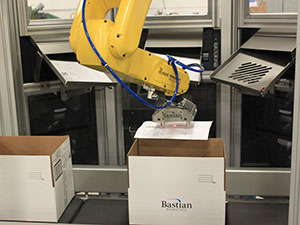The robotic system efficiently prints and inserts documents, while eliminating heavy maintenance requirements of conventional document inserters.
 March 31, 2016 – Bastian Solutions, a global material handling systems integrator, announced today the debut of its robotic document inserter, a robot cell that prints and inserts pack slips, promotional material, and other documents into shipping cartons.
March 31, 2016 – Bastian Solutions, a global material handling systems integrator, announced today the debut of its robotic document inserter, a robot cell that prints and inserts pack slips, promotional material, and other documents into shipping cartons.
“Our ultimate goal in designing this robotic cell was reliability and system uptime,” stated Geoff Schreiber, Robotics Engineering Manager at Bastian Solutions. “Traditional document inserters use belts and sensors that often require daily maintenance. With our robotic inserting system, the effects from paper dust, facility humidity, and paper quality do not negatively impact performance. As typical with robotic systems, our customers should expect uptime approaching 99%.
The robotic document inserter allows standard robotic technology to interface directly with industrial printers, removing any chance of mishandling. In addition, the system interfaces directly with warehouse control systems, removing all third-party software and allowing a single interface and one line of support for the life of the system. Full system performance diagnostics are incorporated within the existing control system for complete visibility to system data and statistics.
Bastian Solutions will be displaying a robotic document inserter demo system at MODEX booth #3779, April 4-7. Attendees are invited to meet with Bastian Solutions during the show to learn more.
# #
For media information: Contact Stefanie Hardy, assistant marketing manager, Bastian Solutions at 317.575.9992 ext. 1079 or shardy@bastiansolutions.com.